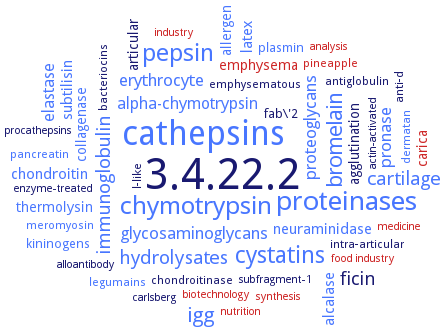3.4.22.2: papain
This is an abbreviated version!
For detailed information about papain, go to the full flat file.

Word Map on EC 3.4.22.2 
-
3.4.22.2
-
cathepsins
-
proteinases
-
chymotrypsin
-
pepsin
-
cystatins
-
bromelain
-
igg
-
hydrolysates
-
cartilage
-
immunoglobulin
-
ficin
-
pronase
-
proteoglycans
-
erythrocyte
-
glycosaminoglycans
-
alpha-chymotrypsin
-
elastase
-
neuraminidase
-
chondroitin
-
alcalase
-
subtilisin
-
latex
-
thermolysin
-
carica
-
allergen
-
articular
-
agglutination
-
collagenase
-
emphysema
-
plasmin
-
kininogens
-
fab\'2
-
anti-d
-
intra-articular
-
bacteriocins
-
pineapple
-
legumains
-
l-like
-
pancreatin
-
meromyosin
-
dermatan
-
emphysematous
-
chondroitinase
-
antiglobulin
-
nutrition
-
actin-activated
-
medicine
-
food industry
-
enzyme-treated
-
industry
-
alloantibody
-
subfragment-1
-
analysis
-
synthesis
-
carlsberg
-
biotechnology
-
procathepsins
- 3.4.22.2
- cathepsins
- proteinases
- chymotrypsin
- pepsin
- cystatins
- bromelain
- igg
- hydrolysates
- cartilage
- immunoglobulin
- ficin
- pronase
- proteoglycans
- erythrocyte
- glycosaminoglycans
- alpha-chymotrypsin
- elastase
- neuraminidase
- chondroitin
- alcalase
- subtilisin
- latex
- thermolysin
- carica
- allergen
-
articular
-
agglutination
- collagenase
- emphysema
- plasmin
- kininogens
-
fab\'2
-
anti-d
-
intra-articular
-
bacteriocins
- pineapple
- legumains
-
l-like
- pancreatin
- meromyosin
- dermatan
-
emphysematous
- chondroitinase
-
antiglobulin
- nutrition
-
actin-activated
- medicine
- food industry
-
enzyme-treated
- industry
-
alloantibody
-
subfragment-1
- analysis
- synthesis
-
carlsberg
- biotechnology
-
procathepsins
Reaction
Hydrolysis of proteins with broad specificity for peptide bonds, but preference for an amino acid bearing a large hydrophobic side chain at the P2 position. Does not accept Val in P1' =
Synonyms
Adolph's Meat Tenderizer, arbuz, CpXCP5, EC 3.4.4.10, enzeco papain, papain, papain-like cysteine protease, papain-like protease, papaine, papaya peptidase I, papaya proteinase 1, Papaya proteinase I, papayotin, PLCP, PLpro, PPI, summetrin, velardon
ECTree
Advanced search results
General Stability
General Stability on EC 3.4.22.2 - papain
Please wait a moment until all data is loaded. This message will disappear when all data is loaded.
chemical modification using citraconic acid, phthalic acid, maleic acid, and succinic acid leads to an increased thermostability of the enzyme
-
compared to free papain, the enzyme non-covalently immobilized on multi-walled carbon nanotubes exhibits significantly improved thermal, pH and recycling stability
free papain loses 60% of its activity after 2 h at 75°C, papain immobilized on the poly(glycidyl methacrylate-co-ethylene dimethylacrylate) monolith loses 10% of its activity
-
Immobilization of papain after chemical modification increases its stability and reusability in alkaline conditions. After adding of detergent powder in distilled water (final concentration of 5-25 mg/ml) to the proteolytic activity test at 45°C, papains modified by 1,2,4-benzenetricarboxylic anhydride and pyromellitic anhydride are more stable. The immobilized papain modified by pyromellitic anhydride still retains about 40% of its activity in the thickest detergent. For the immobilized unmodified papain, the strong surfactant at 15 and 20 mg/ml causes a significant inhibition of 71% and 86%. At lower concentrations (0-10 mg/ml) of the immobilized papain modified by pyromellitic anhydride applied, there is a very slight decrease in the activity.
immobilization of papain by covalent attachment on Sepharose 6B activated by using cyanogen bromide brings about significant enhancement of storage and thermal stability and of stability at extreme pHs
immobilization of the enzyme on Hiflow supercel, kaolinite clay, leaf mucilage, or starch gel leads to better thermal stability at 60-70°C
-
immobilized enzyme does not lose any activity after tereatment with 6 M urea for 270 min, soluble papain loses 81% of its activity after urea treatment
-
immobilized enzyme is stable at 4°C and pH 7.5 for up to 8 months, the soluble enzyme loses activity within 96 h
-
in the presence of 20% (w/v) sorbitol the enzyme retains nearly 65% of its activity after heating at 75°C for 40 min and it retains almost 45% of its activity after heating for 80 min, the maximum effect is seen in the case of 40% (w/v) sorbitol, where the enzyme retains nearly 80 and 70% of its activity after heating at 75°C for 40 and 80 min, respectively, the enzyme also shows increased thermal stability in the presence of sucrose or xylose
-
papain exists in molten globule state at pH 2.0 and in this state protein tends to aggregate in the presence of lower concentrations of guanidine hydrochloride. Such aggregation is prevented if a low concentration of urea is also present in the buffer, in addition, stabilization of the protein is also induced
-
papain immobilized on hybrid nanoflowers retains 88.8% of its initial activity after ten successive cycles of reuse
solid state cysteine increases the stability of n-propanol dehydrated, immobilized enzyme in in low-water tert-butanol medium
-
temperature and guanidine hydrochloride induced unfolding transitions of papain at pH 2.0 are biphasic, implying independent and sequential unfolding of its two domains. The N-domain unfolds initially
-
the operational stability, expressed as the catalytic half-life reaches about 1 week for the enzyme immobilized on the poly(glycidyl methacrylate-co-ethylene dimethylacrylate) monolith under optimal pH and temperature conditions
-


 results (
results ( results (
results ( top
top





